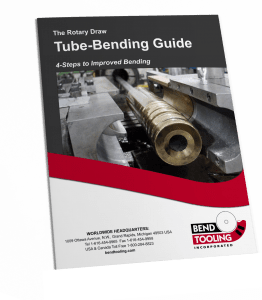The plane perpendicular to the bend die axis of rotation which intersects the tube at full diameter. In the rotary-draw process, the plane of bend is that determined by the machine’s X- and Y-axes. Because in the rotary-draw process the plane of bend is fixed in space at the bend die’s centerline height, it does not require any particular notice in single-bend applications once all of the tools are properly fixtured relative to it.
However, in multiple-bend applications the raw tube material acquires an orientation in terms of plane of bend upon completion of the first bend. All subsequent bends must now be made relative to that orientation. This means rotating the tubing material on the B-axis — i.e., rotary motion centered on the Y-axis — a certain number of degree relative to the plane of the previous bend. On CNC bending machines, the collet grips the tubing material and rotates it as needed. On manual machines, stops must be set for the bent section of the tube to rest against at the correct orientation relative to the plane of the next bend.
Therefore, the terms plane of bend and orientation are closely related, and are sometimes used interchangeably in reference to programming CNC machines. However, there is a useful distinction to be maintained between them. Plane of bend refers to geometry of a tube bend, whereas orientation refers to the motion of the machine to locate to the tube bend.

